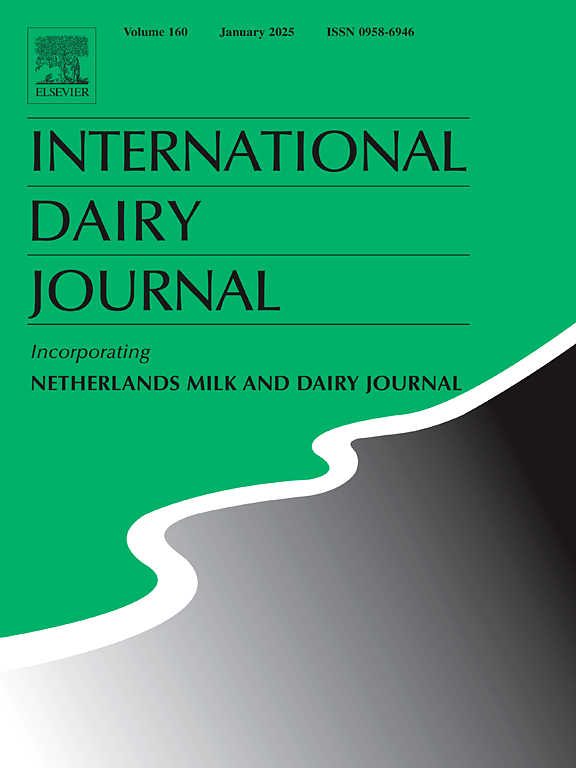电纺仿生包装材料在蒙古奶酪长效保鲜中的应用
IF 3.1
3区 农林科学
Q2 FOOD SCIENCE & TECHNOLOGY
引用次数: 0
摘要
这项工作的目的是制造一种基于聚乙烯醇、聚乙烯氧化物和丝素混合物的茧壳启发包装材料。采用静电纺丝法将具有抗菌作用的植物乳杆菌生后制剂(LPP)和植物乳杆菌细胞(LPC)加入到基质中。在25℃条件下对蒙古奶酪进行8 d的仿生包装。结果表明,在没有外部营养的情况下,包埋的LPC可以维持约4 d的活力,在蒙古奶酪的营养条件下可以延长至8 d。LPP对5种食源性致病菌有明显的抑制作用。质量评价结果表明,纳米纤维的抗菌和抗真菌性能在8 d后使总活菌数减少3.5 log (CFU/g),酵母和霉菌总数减少1.3 log (CFU/g)。此外,仿生包装涂层样品在保持质量、减少重量损失、延缓蛋白质水解和脂肪沉淀方面表现出更好的处理性能。因此,这种仿生包装代表了保存蒙古奶酪的可行的替代抗菌策略。本文章由计算机程序翻译,如有差异,请以英文原文为准。
Application of electrospun biomimetic packaging materials for prolonged preservation and quality retention of Mongolian cheese
The objective of this work was to fabricate a cocoon shell-inspired packaging materials based on Poly (vinyl alcohol), polyethylene oxide and silk fibroin blends. The L. plantarum postbiotics (LPP) and L. plantarum cells (LPC) with antimicrobial effects were incorporated into the matrix through electrospinning process. The biomimetic packaging was applied for Mongolian cheese during 8 d storage at 25 °C. Results showed that the embedded LPC could sustain viability for approximately 4 d without external nutrients and extend to 8 d with nutrient provision from Mongolian cheese. LPP exhibited a significant inhibition effect on five foodborne pathogenic bacteria. Quality evaluation results indicated that the antimicrobial and antifungal properties of the nanofibers reduced the total viable count by 3.5 log (CFU/g) and the total yeast and mold count by 1.3 log (CFU/g) after 8 d of storage. Furthermore, biomimetic packaging coated samples presented better treatment performance in maintaining the quality, reducing weight loss, retarding proteolysis and fat precipitation. Consequently, this biomimetic packaging represents a viable alternative antimicrobial strategy for the preservation of Mongolian cheese.
求助全文
通过发布文献求助,成功后即可免费获取论文全文。
去求助
来源期刊

International Dairy Journal
工程技术-食品科技
CiteScore
6.50
自引率
9.70%
发文量
200
审稿时长
49 days
期刊介绍:
The International Dairy Journal publishes significant advancements in dairy science and technology in the form of research articles and critical reviews that are of relevance to the broader international dairy community. Within this scope, research on the science and technology of milk and dairy products and the nutritional and health aspects of dairy foods are included; the journal pays particular attention to applied research and its interface with the dairy industry.
The journal''s coverage includes the following, where directly applicable to dairy science and technology:
• Chemistry and physico-chemical properties of milk constituents
• Microbiology, food safety, enzymology, biotechnology
• Processing and engineering
• Emulsion science, food structure, and texture
• Raw material quality and effect on relevant products
• Flavour and off-flavour development
• Technological functionality and applications of dairy ingredients
• Sensory and consumer sciences
• Nutrition and substantiation of human health implications of milk components or dairy products
International Dairy Journal does not publish papers related to milk production, animal health and other aspects of on-farm milk production unless there is a clear relationship to dairy technology, human health or final product quality.
 求助内容:
求助内容: 应助结果提醒方式:
应助结果提醒方式:


